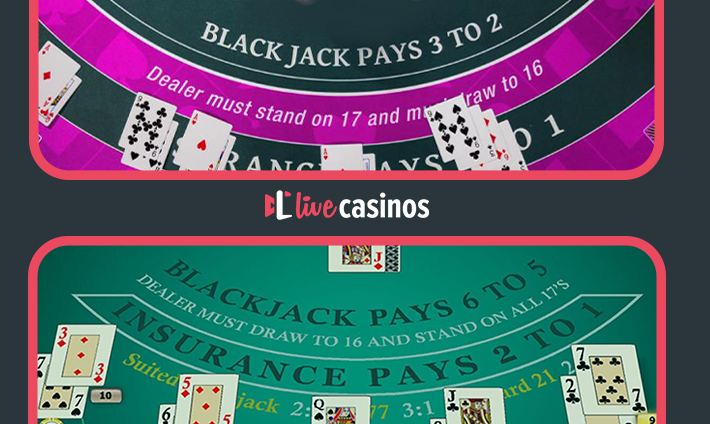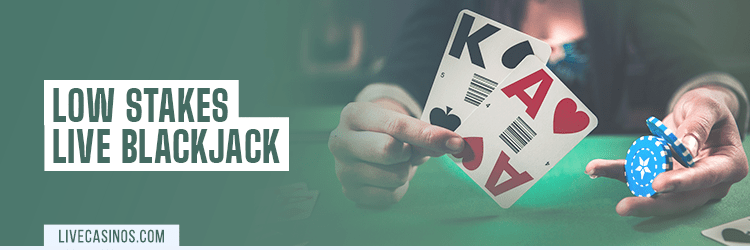Blackjack tables that pay 3:2 for a natural 21 have a 1.39% lower house edge than those with 6:5 payouts for the same result.
Note that this figure assumes that all other table rules are identical, and that 6 decks are used per shoe.
But why is the house edge that different for a small payout difference for a comparatively rare outcome?
Let’s explain with a simple formula.
In 6-deck blackjack, every player hand has a roughly 4.75% chance to win with a natural 21.
The difference between a 3:2 payout and a 6:5 payout can be described as follows:
- A 3:2 payout means that the player wins 1.5x their stake
- A 6:5 payout means that the player wins 1.2x their stake
- That means that the latter pays 0.3x of the stake less
As such, we can calculate the difference in expected value by multiplying the payout difference by its probability of occurring:
0.0475 x 0.3 = 0.01425
If we translate that into the usual percentage-based house edge formula, it comes out to a 1.425% difference in house edge.
According to the Wizard of Odds’ rule variation breakdown, this makes it the single worst rule variation in blackjack in terms of how bad it is for the player’s expected value.
What That Means In Dollars Per Hour
From an outside perspective, this might not seem like a major issue. After all, a Natural Win is still a fairly rare sight. The difference in rewards is only around 20% for around 4.75% of all rounds.
However, if you play enough hands, this can have a devastating effect on your bankroll.
For starters, remember that blackjack is a losing game for players – as are all forms of gambling. It has an inherent house edge that you cannot overcome without using advantage play tactics such as card counting.
A house edge can be described as the expected loss for the player per bet. Most common variations of blackjack have a house edge of around 0.5%.
That means that you can expect to lose around 0.5% of your stake per bet, on average, assuming you’re playing with 3:2 blackjack payouts and basic blackjack strategy.
Under those same circumstances, you can expect to lose 1.9% of your bet, per round, on average, if you play 3:2 blackjack.
Of course, we should keep in mind that this is a difference in terms of risk and reward. You’re risking the same money, but you’re winning slightly less on average. ‘On average’ is the keyword here: most winning hands pay the usual 1:1, but you’ll win around 30% of your stake less once in every 21 rounds (4.75% of the time.)
This is especially noticeable if you play a lot of hands consecutively.
Let’s put this into real-world figures.
According to data, a single player alone at a table can play up to 209 hands per hour. Of course, this number drops significantly if there are more players at the table: ~105 hands per hour for 3 players, and around ~70 hands for a full 7-seat table.
The table below shows a difference in losses per hour between blackjack tables with 3:2 and 6:5 payouts, respectively, while betting $10 per hand.
The table assumes basic blackjack strategy and that all other rules are identical.
In other words, playing $10 per hand at a table with 6:5 blackjack payouts can cost you tens of dollars per hour. Obviously, higher stakes mean higher losses as well.
Full Comparison: Common Rule Sets (Why Rules Stack)
Importantly, the payout rule is just one part of a blackjack table ruleset. There are other differences that can also alter the house edge, and thus your expected value.
For example, 6-deck tables that allow players to surrender after a dealer peek have a 0.07% lower house edge than those that don’t. Additionally, tables on which the dealer must stand on a soft 17 have a 0.22% lower house edge than those on which dealers hit Soft 17s.
Importantly, these house edge differences all stack. A table with two unfavourable rules will have its house edge affected by both of them.
We’ll showcase how common rule variations in blackjack affect the house edge on the table below.
However, we should first make a baseline. Most live casino blackjack tables have the following rules:
- 6-8 decks
- Dealer stands on Soft 17
- Double after Split allowed
- Players can double any hand
- Re-splits allowed, but not for Aces
- No surrender
- 3:2 blackjack payouts
With these rules, most blackjack games have a house edge of around 0.5%.
Compared to a table like that, common rule variations can have both a positive and a negative effect on the house edge:
*Some rules decrease the house edge of blackjack, indicating that they’re player-friendly.
The main takeaway is this:
Blackjack tables with 6:5 payouts are comparatively worse than those with 3:2 payouts. However, players should also consider other table rules before deciding which table to play on.
For example, single-deck blackjack has a lower house edge than 6 or 8-deck variants. That’s why some casinos offer 6:5 blackjack payouts on such tables to counteract the player advantage.









































 Roulette
Roulette
 Blackjack
Blackjack
 Baccarat
Baccarat
 Poker
Poker
 Sic Bo
Sic Bo
 Dragon Tiger
Dragon Tiger
 Game Shows
Game Shows  Top 5 Games
Top 5 Games  See more
See more  Roulette Casinos
Roulette Casinos  Low Limit
Low Limit  High Limit / VIP
High Limit / VIP  Exclusive
Exclusive  How to Play
How to Play  Basic Strategy
Basic Strategy  Top Tips
Top Tips  FAQ
FAQ  Blackjack Casinos
Blackjack Casinos  Baccarat Casinos
Baccarat Casinos  Bonuses
Bonuses  Poker Casinos
Poker Casinos  Game Providers
Game Providers  Sic Bo Casinos
Sic Bo Casinos  Dragon Tiger Casinos
Dragon Tiger Casinos  Credit and Debit Card
Credit and Debit Card  e-Wallet
e-Wallet  Cryptocurrency
Cryptocurrency  Bank and Checks
Bank and Checks  Pay by Phone and SMS
Pay by Phone and SMS  See more
See more  How-To Guides
How-To Guides  Top Lists
Top Lists  In-Depth
In-Depth  Strategy
Strategy  Casino & Games
Casino & Games  Insight
Insight  News
News  Promotions
Promotions 
 Guide to Live Casinos
Guide to Live Casinos  Top 10 Live Casino Tips
Top 10 Live Casino Tips  Studio Locations
Studio Locations  FAQ & Help
FAQ & Help  Meet The Dealers
Meet The Dealers  Our Awards
Our Awards  How We Rate
How We Rate  Responsible Gambling
Responsible Gambling 




























 ENG
ENG 







 Facebook
Facebook
 Pinterest
Pinterest
 Twitter
Twitter
 LinkedIn
LinkedIn
 Copy Link
Copy Link 



















